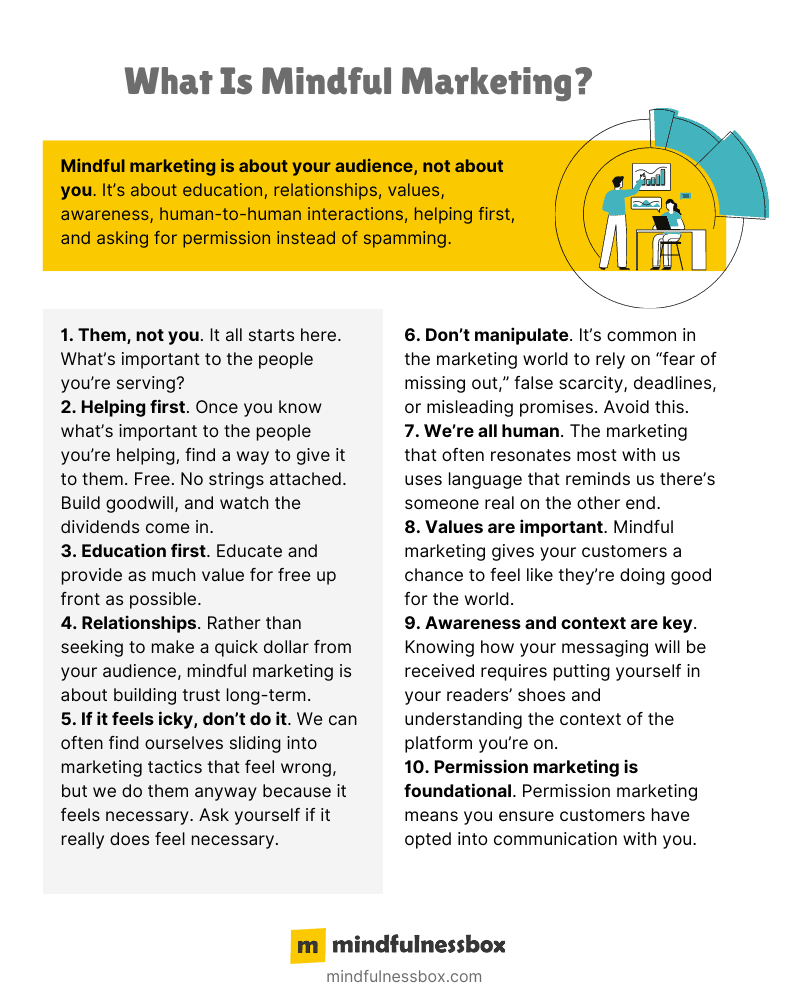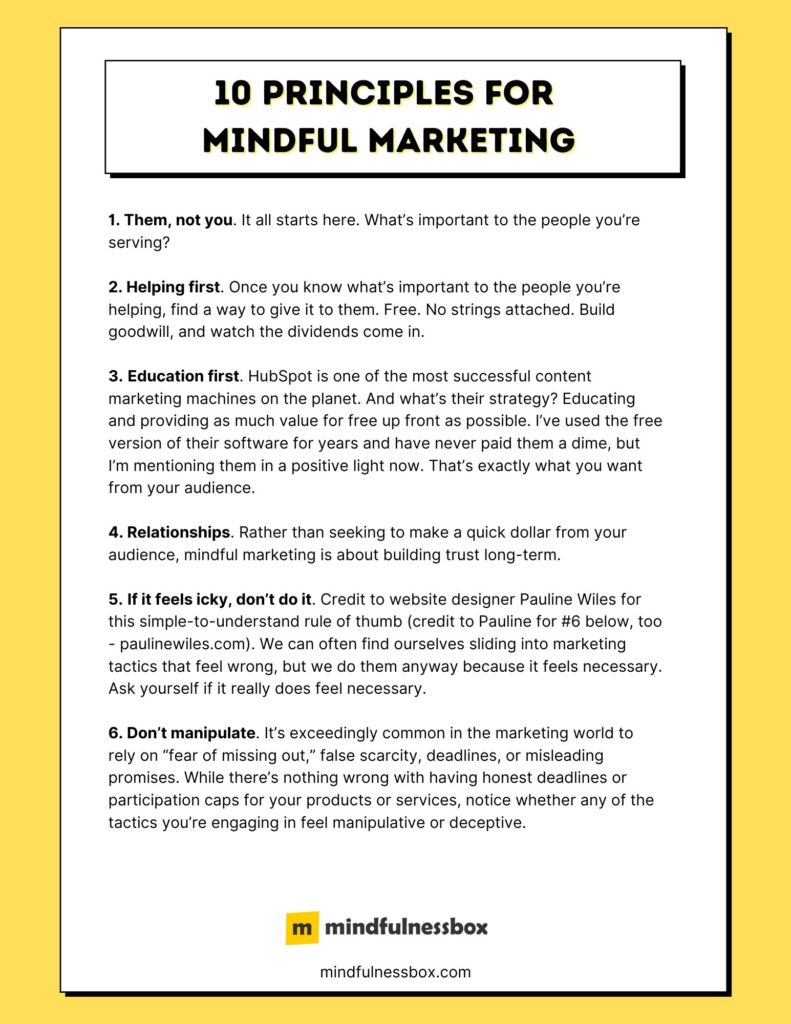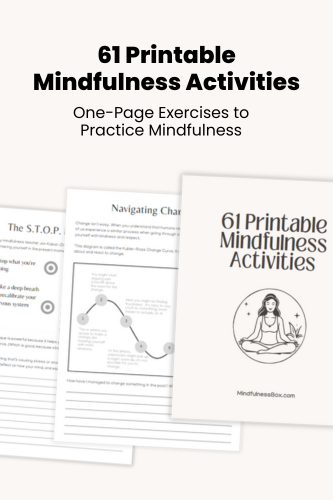Mindful marketing is about your audience, not about you. It’s about education, relationships, values, awareness, human-to-human interactions, helping first, and asking for permission instead of spamming.
The best way to explain mindful marketing is simple:
Default to helping people first.
Get dozens of one-page exercises to help practice mindfulness, meditation, gratitude, and self love. Perfect for printable handouts when teaching mindfulness to groups, students, or in the workplace.
To see examples, plus a full list of the 61 exercises included, click below.
Some companies operate based on what THEY need. The focus is on 100 cold calls a day to hit lead generation quotas, for example, or on low-quality content marketing that’s intended to game search engines rather than help people solve a problem. Rather than adding value, it’s extractive or manipulative.
And the results can be tremendous in terms of impact and brand sentiment.
Think about the difference in the way you think of your local telecom company, for example, and what comes to mind when you think of your favorite brand.
Let’s dive into what mindful marketing is, a few examples, and how you can apply these principles in your own marketing efforts.
What is mindful marketing?

Here are ten principles to help you conceptualize what it means to create a marketing approach based around mindfulness:
- Them, not you. It all starts here. What’s important to the people you’re serving?
- Helping first. Once you know what’s important to the people you’re helping, find a way to give it to them. Free. No strings attached. Build goodwill, and watch the dividends come in.
- Education first. HubSpot is one of the most successful content marketing machines on the planet. And what’s their strategy? Educating and providing as much value for free up front as possible. I’ve used the free version of their software for years and have never paid them a dime, but I’m mentioning them in a positive light now. That’s exactly what you want from your audience.
- Relationships. Rather than seeking to make a quick dollar from your audience, mindful marketing is about building trust long-term.
- If it feels icky, don’t do it. Credit to website designer Pauline Wiles for this simple-to-understand rule of thumb (credit to Pauline for #6 below, too). We can often find ourselves sliding into marketing tactics that feel wrong, but we do them anyway because it feels necessary. Ask yourself if it really does feel necessary.
- Don’t manipulate. It’s exceedingly common in the marketing world to rely on “fear of missing out,” false scarcity, deadlines, or misleading promises. While there’s nothing wrong with having honest deadlines or participation caps for your products or services, notice whether any of the tactics you’re engaging in feel manipulative or deceptive.
- We’re all human. There’s nothing worse than corporate jargon. “We here at CompoTech Solutions deliver enterprise solutions for discerning CMOs.” Ugh. That’s why the marketing that often resonates most with us uses language that reminds us there’s someone real on the other end.
- Values are important. Your customers care about stuff. So should you. Mindful marketing gives your customers a chance to feel like they’re doing good for the world, even if all they’re doing is informing themselves by reading your content. That’s why programs like TOMS “⅓ of profits for grassroots good” are invaluable to brands. Values are also about being true to your own values with the services you offer, the products you create, and the messaging you put out there.
- Awareness and context are key. Have you ever seen the terrible PR that rains down on companies that are perceived to be capitalizing on unfortunate news events, or simply post something tone-deaf on social media? Knowing how your messaging will be received requires putting yourself in your readers’ shoes, and also understanding the context of the platform you’re on. LinkedIn messaging is entirely different from TikTok.
- Permission marketing is foundational. Permission marketing is a concept coined by Seth Godin. Simply explained, it’s the opposite of spam. Rather than blasting out unsolicited communication, with permission marketing, you reach out only when customers have asked you to. Often used in the context of an email list, permission marketing means you ensure customers have opted into communication with you. Often, it means giving them options to choose what kind of communication they’d like to receive.
You can download a PDF of the list above here.
How does mindfulness tie into marketing?

You’re familiar with mindfulness.
It’s the buzzword that’s everywhere these days, from corporate boardrooms to yoga classes.
But how does mindfulness, which focuses on cultivating a nonjudgmental awareness of the present moment, actually tie into marketing?
Simple: because mindfulness is all about noticing how you’re feeling about your impact on yourself and others. And when you’re marketing, you have plenty of impact on yourself as well as the world around you.
Pauline Wiles, a marketer and web designer, has written about what mindful marketing looks like for her. A few of her comments that resonate with me most are:
“Remaining true to your values in every product, service or offering you create.”
“Taking pleasure in connecting with your audience and, wherever possible, getting to know them as individuals.”
“If a marketing tactic feels icky, don’t do it.”
“Inviting your clients to work with you, or customers to buy from you, without inflating your promises or relying on Fear Of Missing Out.”
“Embracing (not just accepting) the reality that for most of us, promoting our work will be a marathon, not a sprint.”
“Keeping messaging simple… so that your visitor finds key information quickly, not a brain dump of every thought you’ve ever had about your product or service.”
“Showing up on 1 or 2 social media channels, not all of them. Walking away from any social media platform where you wouldn’t hang out for fun.”
Mindful marketing ties into a bigger mission

If your marketing content is a series of press releases, updates about your company, and LinkedIn posts about who just got hired for Senior VP of Human Resources, I’ve got some disappointing news for you:
No one cares.
It might as well have never happened. This kind of marketing isn’t doing anyone any good.
Mindful marketing is about looking at this kind of content from your customers’ point of view. When you do, you understand that it does nothing for them, and you can ask yourself “What would help them? What would matter to them? What would make them care?”
Awareness of your customers’ point of view and the role you and your company occupy in the world can lead to realizations about the kind of values you want to stand for.
And usually, the values that matter to your customers are the values that need to matter to you.
That way, when you put out your next clever marketing campaign, you’ll rest easy knowing that one of two things will happen:
- You’ll be helping or educating your customers, which will build goodwill
- You’ll be advocating for values your customers care about, which will build goodwill
Either way, something different will be happening:
Your marketing will matter because it’s become personal to the people receiving it.
How to start marketing your business mindfully

I’ll be the first to admit I haven’t always marketed mindfully.
It’s harder in certain jobs, or certain industries.
In high-competition markets with low-cost products, you might not have the margins to spend on marketing as creatively and thoughtfully as you’d like. And you might not have the patience or the financial resources to build up a content marketing machine big enough to allow people to come to you.
It’s also possible you have a job title like Lead Generation Specialist, for example. If that’s the case, reaching out to people who haven’t given you permission to reach out is literally a part of your job description.
That’s okay. We’re all operating in the reality of the world we live in right now.
But over time, more and more businesses are moving towards a helping-first, education-first, relationship-oriented, permission-based content marketing strategy. It may take longer to get off the ground, but it’s got more staying power. And the goodwill generated for your brand can be tremendous.
So, as you’re getting started, remember:
Default to helping people first.
The rest will follow.


My mindfulness practice kicked off in 2016 with a ten-day silent retreat. Since then, I’ve read dozens of books about mindfulness and completed hundreds of hours of meditation. Thinking about what makes humans happy, calm, and peaceful is endlessly fascinating to me.


